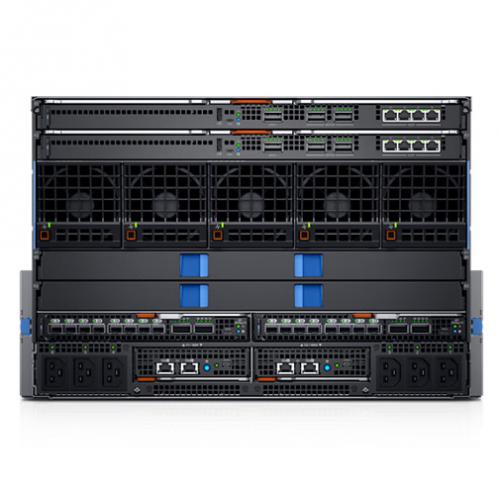Brand: Dell
Total Fibre Channel Ports:
Up to 16 internal server facing and up to 16 external fabric facing ports (8-port increments through dynamic
Ports on Demand (POD) license.
The 16 internal server facing ports operate at either 16 Gbps or 32 Gbps speed depending on the
minimezzanine adapter, and do not require any optical transceivers.
The 16 external fabric facing ports are available in two different port types:
8 external SFP+ ports operate at 8Gbps, 16Gbps, or 32Gbps speed
2 external QSFP+ ports offer 4 ports each operate at 16Gbps or 32Gbps speed
Supported Optics:
Transceiver, 16Gbps FC, SWL SFP
Transceiver, 16Gbps FC, LWL SFP
Transceiver, 32Gbps FC, SWL SFP
Transceiver, 32Gbps FC, LWL SFP
Transceiver, 16Gbps FC, SW4 QSFP (supports 1x4 Breakout)
Transceiver, 32Gbps FC, SW4 QSFP (supports 1x4 Breakout)
- ANSI Fibre Channel protocol: Fibre Channel Physical and Signaling Interface standard (FC-PH)
- Modes of operation: Fibre Channel Class 2 and Class 3
- Fabric initialization: Complies with FC-SW-3 Rev. 6.6
- Scalability: Full-fabric architecture with a maximum of 239 switches
- Certified maximum: 6,000 active nodes, 56 switches, 19 hops in a Fabric OS® fabrics
- ISL trunking: Frame-based trunking with up to eight ports per ISL trunk for an up to 256 Gbps per ISL; supporting trunk
- Exchange-based load balancing across ISLs with DPS included in Fabric OS®
- Max. Switching bandwidth: 1024 Gbps (32 * 32 Gbps) in Full Fabric Switch mode
- Max. Throughput: 512 Gbps (16 * 32 Gbps) in Access Gateway mode (default mode)
- Maximum port-to-port latency Latency for locally switched ports is ? 900 ns (including FEC)
- Maximum frame size: 2,112-byte payload
- Frame buffers: 2,000 dynamically allocated
- Classes of services: Class 2, Class 3, Class F (inter-switch frames)
- Port types: F_Port, E_Port, M_Port, D_Port (ClearLink Diagnostic Port), N_Port
- Data traffic types: Fabric switch supporting unicast
- Fabric Services: Monitoring and Alerting Policy Suite (MAPS); Flow Vision; Brocade Adaptive Networking (Traffic Isolation,
- QoS)
- Fabric Performance Impact (FPI) Monitoring; Slow Drain Device Quarantine (SDDQ); Brocade Advanced
- Zoning (default zoning, port/WWN zoning, broadcast zoning, peer zoning, target-driven zoning); Dynamic
- Fabric Provisioning (DFP); Dynamic Path Selection (DPS); Brocade Extended Fabrics; Enhanced
- BB credit recovery; FDMI; Frame Redirection; Frame-based Trunking; FSPF; Brocade ISL Trunking;
- Management Server; NPIV; NTPv3; Registered State Change Notification (RSCN); Reliable Commit
- Service (RCS); Simple Name Server (SNS); Read Diagnostics Parameter (RDP), VM Insight
Supported management software:
HTTP, SNMP v1/v3 (FE MIB, FC Management MIB), SSH; Auditing, Syslog; Brocade Advanced Web Tools;
Command Line Interface (CLI); SMI-S compliant; Administrative Domains; trial licenses for add-on
capabilities
Security:
DH-CHAP (between switches and end devices), FCAP switch authentication; HTTPS, IPsec, IP filtering,
LDAP with IPv6, OpenLDAP, Port Binding, RADIUS, TACACS+, User-defined Role-Based Access Control
(RBAC), Secure Copy (SCP), Secure RPC, Secure Syslog, SFTP, SSH v2, SSL, Switch Binding, Trusted
Switch
Management access: 1 micro USB type B port for console/management
Diagnostic:
ClearLink optics and cable diagnostics, including electrical/optical loopback, link traffic/latency/distance; flow
mirroring; built-in flow generator; POST and embedded online/offline diagnostics, including environmental
monitoring, FCping and Pathinfo (FC traceroute), frame viewer, non-disruptive daemon restart, optics
health monitoring, power monitoring, RAStrace logging, and Rolling Reboot Detection (RRD)
